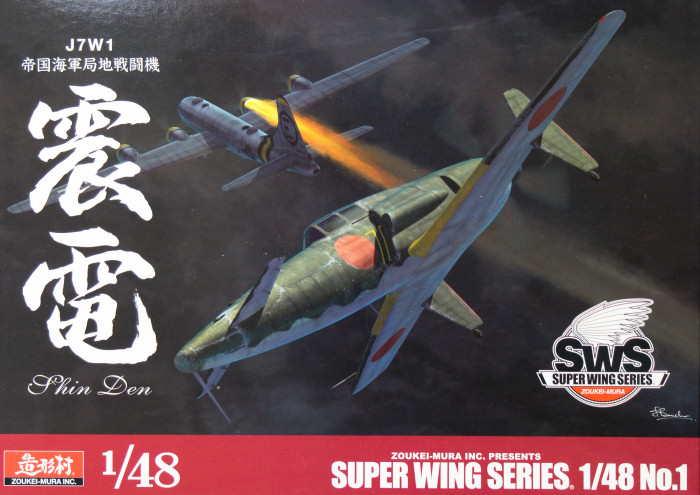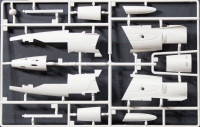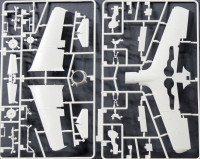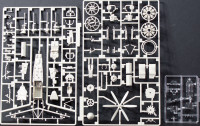
Zoukei-Mura Inc. 1/48 J7W1 Shinden Kit First Look
By Michael Benolkin
| Date of Review | November 2013 | Manufacturer | Zoukei-Mura Inc. |
|---|---|---|---|
| Subject | J7W1 Shinden | Scale | 1/48 |
| Kit Number | 48001 | Primary Media | Styrene |
| Pros | Beautiful molding, excellent detail | Cons | Nothing noted |
| Skill Level | Experienced | MSRP (USD) | $48.00 |
First Look
 |
 |
 |
 |
Captain Masayoshi Tusuruno was looking for innovative new designs that could be employed within the air arm of the Imperial Japanese Navy. The airframe configuration that showed great promise was a canard design and in 1943, flight testing of three MXY6 gliders proved out that promise. One of the gliders was fitted with a 22 hp engine and flight test results impressed the Navy enough to order the development of a fighter based on this canard configuration.
Captain Tusuruno and a special design team were sent to oversee the development of this new fighter to be built at Kyushu Aircraft Company. Kyushu had sufficient resources available to take on this project as opposed to the other aircraft companies that were producing various fighters and bombers to support ongoing Army and Navy orders.
What emerged from the drawing boards at Kyushu was a very potent interceptor that was powered by a supercharged 2,130 hp engine turning an eight-bladed pusher propeller, armed with four 30mm cannons, and had a take-off weight under 12,000 pounds. Designated J7W1 Shinden (Magnificent Lightning), this fighter was the ideal answer to deal with the heavily armed B-29 Superfortress. Flight testing of the Shinden revealed some engineering issues that needed to be sorted out including inadequate cooling when running the engine on the ground, excessive torque from that huge engine/propeller combination, as well as some vibration issues. The war ended before the two prototypes had accumulated 45 minutes of flight time over three flights.
Almost three years ago, we had the opportunity to assess the first kit from a new model company in Japan - Zoukei-Mura Inc. This kit was a masterpiece as it featured details that most companies would avoid and didn't waste time with details that couldn't be seen after assembly. Engineering skills and restraint, two very good and unique attributes in this hobby industry. The first kit they produced was the J7W1 Shinden in 1/32 scale ( look here) and the kit is nothing less than magnificent.
Now Zoukei-Mura is putting their research and digital design data back to work scaling down that first release into their first release in 1/48 scale. At the IPMS/USA Nationals, we saw the second subject in 1/48 scale which happens to be their second release in 1/32 scale - the Ta 152H-1. Yes!!
This kit is presented on five parts trees molded in gray styrene plus one molded in clear. You can see in the illustrations as well as the sprues that this kit was tooled from advanced computer CAD technology. Construction starts with the Mitsubishi Ha-43 engine and this engine is a beauty. With all of the detail that goes into this powerplant, it makes you wonder how it will fit inside the fuselage, but fit it does. Don't worry, the model is engineered so you can see all of that detail with the cowling panels removed. The supercharger mounts ahead of the engine and provides pressurized air to the engine to allow it to breath at high altitudes. The exhaust system is an interesting engineering marvel in how it is ducted into two fuselage channels that are ram-air cooled to damp out exhast flames for night intercepts. In fact, if you look at the completed engine assembly, you'll see just how well this aircraft was laid out to accept a turbine engine had the war continued.
The cockpit layout in this kit is quite exceptional right down to the sub-floor. The structural detailing is really impressive and the kit captures all of the various control handles from trim to flaps. Two pilot seats are included, one basic seat, and one with seatbelts and shoulder harness detail molded into the part. The instrument panel is nicely detailed and the kit also provides a full decal to cover the panel.
When you get the cockpit tub built up, you attach one fuel cell to the rear of the cockpit bulkhead, then mount the cockpit tub to a unique fuselage/wing frame where you add the main fuel cell under the cockpit. This frame structure provides a nice structural foundation for the fuselage and wings to attach and support the weight of the model during handling.
The gun bay in the nose is equipped with four nicely detailed 30mm cannons. Turned metal cannons are now available should you want to add some detail, but these can be made to look nice with a little patience out of the box. The instructions show you how to hollow out the ends of the barrels to get that essential bit of reality with your guns.
The fuselage and wings go together around the structural frame and the wing portion of that frame also serves as the interior structure of the main wheel wells.
Once the wings and fuselage panels are in place, it is time to build up the ducts and mounts for that rear-mounted Mitsubishi engine. As I mentioned earlier, the engineering in this kit is as impressive as the layout of the full-scale aircraft!
The landing gear is next and the styrene nose gear strut halves are hollow to accept a metal rod for strength. For those who'd rather have metal gear struts, these are also available as separately priced options.
So the features and highlights of this kit include:
- Exquisite Mitsubishi engine
- Beautiful cockpit
- Choice of positionable canopy or one-piece canopy/windscreen
- Detailed fuel cells
- Positionable landing flaps
- Positionable flight control surfaces
- Oxygen and compressed gas cylinders
- Detailed 30mm gun installations
- Positionable gun access doors
- Positionable engine cowling panels
- Choice of open or closed cowl flaps
- Nicely detailed landing gear
The kit comes with a nice set of decals which provide generic markings for the type (since none of these entered squadron service to get their distinctive markings). The paint instructions are provided using Vallejo paints.
This is a truly exceptional kit at a really nice price. What's more, this is the best J7W kit in 1/48 scale. If you are a fan of Japanese aviation or enjoy building something that is going to look incredible on your shelf, this is definitely one kit you'll want to add to your project list!
My sincere thanks to Zoukei-Mura Inc. and Volks USA for this review sample!







